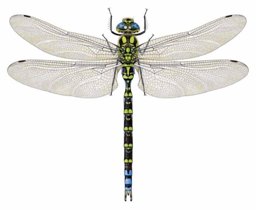| Aeshna
cyanea |
 |
|
Common Name:
|
Southern Hawker, Blue Darner |
|
Odonata |
|
Order:
|
Odonata |
|
Suborder:
|
Anisoptera |
|
Family:
|
Aeshnidae |
|
Genus:
|
Aeshna |
|
Species:
|
A. cyanea |
|
|
| The
Name |
| Aeshna cyanea, the Southern Hawker
or Blue Darner, is a large, brightly coloured Dragonfly. It has green markings
on the black bodies, and the male also has blue spots on the abdomen. Male
southern hawkers have green markings with blue markings on the last three
segments of the abdomen. The female has all green markings.
The males are often seen patrolling
by a ponds edge or river, where they fight away intruders, crashing into
rival males and spiralling through the air. The females are quite inconspicuous
when they lay their eggs, but they sometimes give away their spot by clattering
up from the reeds. If you look carefully you can sometimes find them ovipositing
(laying eggs) into some moss, reeds or rotten wood. The males are sometimes
very curious and come flying up to you, allowing a close view.
Distinguished from other Hawkers
by the two 'head-light' markings on the thorax and also by the paired spots
on the last two abdominal segments merging.
|
| The
Characteristics |
| The Southern Hawker is a large hawker,
with wingspan approximately 95mm, body length around 75mm. The species'
most distinguishing features include the brown-and-green thorax and abdomen,
the male's blue eye spots, and, especially, the uninterrupted coloured
bands (blue in the male; green in the female) which cover S9 and S10. In
all other European Aeshna species those bands are interrupted by the usual
dark dorsal line. Usually males are black with large apple green spots
on the abdomen and with blue markings on the last two segments and along
the sides of the abdomen. Thorax sides are largely bright green, as is
the face, with blue eyes. Females are duller, having pale green and blue
markings.
The Southern Hawker breeds in still
or slow-flowing water, but will wander widely, and is often seen in gardens
and open woodland. This is an inquisitive species and will approach people.
Aeshna cyanea is typically associated with small lakes and garden ponds.
The males tend to be very inquisitive and will often fly up to an observer
to check them out.
The adult eats various insects, caught
on the wing. The nymphs feed on aquatic insects, tadpoles and small fish
ambushed in the pond they frequent until they emerge as adults in July
and August after three years' development.
|
| The
Reproduction and Development |
| Southern Hawker is often recorded
well away from water, though for breeding purposes it prefers smaller water
bodies with wooded margins; garden pools are well used breeding sites.
The eggs are laid by jabbing the
abdomen into rotting vegetation or wood. The eggs hatch in the spring,
after being laid in the previous summer or autumn. The larvae live on small
tadpoles and invertebrates. They emerge after 2-3 years.
Adults fly from July to start of
October.
|
| The
Distribution |
| Aeshna cyanea is a one of the commonest
species of the genus in central Europe. It occurs throughout Europe but
tends to be rare in the South-East and South-West and in the North of Scandinavia.
Northern African populations are
genetically distinct from the European populations (based on ecology, but
no genetic data to date; Samraoui, pers. comm.). It is highly localised
in northern Africa, where it is only known from two localities in Algeria.
The population is severely fragmented. The presence if the species in Morocco
is uncertain and needs to be confirmed.
|
| The
Protection Status |
| IUCN Red List as Endangered B2ab(i,
iii) |
|
References:
http://en.wikipedia.org/wiki/Southern_Hawker
http://www.iucnredlist.org/details/165524/9
http://www.dragonflypix.com/speciespages/aeshna_cyanea.html
|
| The
Species on Stamps |
|
|
|
|
With courteous to Mr. Richard
Lewington for the Dragonfly Illustration
|
|
|
|
Home | Country
List | Species List
|